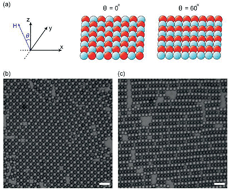Phase transformations in binary colloidal monolayers†
Abstract
Phase transformations can be difficult to characterize at the microscopic level due to the inability to directly observe individual atomic motions. Model colloidal systems, by contrast, permit the direct observation of individual particle dynamics and of collective rearrangements, which allows for real-space characterization of phase transitions. Here, we study a quasi-two-dimensional, binary colloidal alloy that exhibits liquid–solid and solid–solid phase transitions, focusing on the kinetics of a diffusionless transformation between two crystal phases. Experiments are conducted on a monolayer of magnetic and nonmagnetic spheres suspended in a thin layer of ferrofluid and exposed to a tunable magnetic field. A theoretical model of hard spheres with point dipoles at their centers is used to guide the choice of experimental parameters and characterize the underlying materials physics. When the applied field is normal to the fluid layer, a checkerboard crystal forms; when the angle between the field and the normal is sufficiently large, a striped crystal assembles. As the field is slowly tilted away from the normal, we find that the transformation pathway between the two phases depends strongly on crystal orientation, field strength, and degree of confinement of the monolayer. In some cases, the pathway occurs by smooth magnetostrictive shear, while in others it involves the sudden formation of martensitic plates.


 Please wait while we load your content...
Please wait while we load your content...